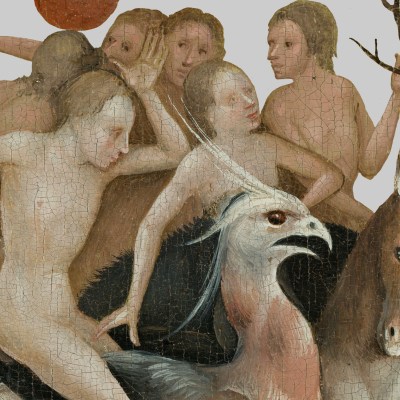At first glance, the pairing of Francisco de Goya and Paula Rego seems like an ideal one. If Goya’s influence on Rego will hardly come as a revelation to most viewers, it is nevertheless something that bears re-examining. Consciously working in an Iberian tradition in which Goya was a central figure, Rego was a true fan. His influence on her is so pervasive that it is hard to point to specifics: alongside Velázquez and Picasso, Goya is ever-present in her work. Indeed, as the best part of this exhibition shows, she went to bed each night under the watchful gaze of seven plates from his Caprichos (‘Caprices’, 1797–98) and Desastres de la Guerra (‘Disasters of War’, 1808–20). It is the sort of bedroom decor that could only appeal to someone of a very specific kind of mind – one deeply invested in what the curators of this show term the ‘uncanny’.
It is a shame, knowing this, that ‘Uncanny Visions’ does so little with such a promising frame. Billed as a ‘major exhibition’, it lands as a decidedly minor one. The main focus is a comparison between Goya’s late and baffling Disparates (‘Follies’, 1815–24) and Rego’s Nursery Rhymes prints (1989). A second section shows a selection of the Goya works that Rego had in her bedroom alongside some of the marvellous grotesque dolls that inhabited her studio, and a small selection of gouaches on paper from the 1990s and early 2000s.
Punctual Folly from the series The Follies (1815–24), Francisco de Goya. © The Trustees of the British Museum

The fault is not in the art. Taken separately, the Disparates and the Nursery Rhymes are as remarkable as ever. The Disparates rank among Goya’s strangest and most gnomic works. Their production overlapped with that of both the Desastres de la Guerra and the terrifying ‘Black Paintings’ that would come to cover the walls of the artist’s home, El Quinta del Sordo – a country house just outside Madrid. Not published until long after the artist’s death, the 18 prints that make up the series see Goya at a kind of simultaneous acme and nadir: an artist at the highest pitch of his powers, and the lowest pitch of his mood.
The world of the Disparates channels the nightmarish spirit of the Caprichos and Desastres, but takes it ever further, into a seemingly private realm of meaning. In El caballo raptor (‘The Horse-Abductor’), a woman is carried off by a horse that rears and bends its head to bite at her dress, as if intent on raping her. It is a folk tale, linked to Apuleius’s The Golden Ass, but what we are meant to make of it is a mystery. In Disparate general (‘General Folly’), a disordered mass of characters emerges from blackness, while what seems to be a mock baptism of an armful of cats takes place in the foreground. Shrouded in murky aquatint, it is both literally and figuratively impossible to make out what is going on. If others – such as the monumental hooded figure of Fear standing over terrified soldiers in Disparate de miedo (‘Folly of Fear’) – speak for themselves, the majority of the Disparates are as baffling as they are brilliant.
Folly of Fear from the series The Follies (1815–24) by Francisco de Goya. © The Higgins Bedford

Superficially, Rego’s Nursery Rhymes have much in common with them: they too are strange, dark and, yes, uncanny. But direct comparison only shows how far removed Rego is from Goya. There is darkness here, but even more, there seems to be delight. Her prints are gorgeous and strange, teasing out and playing with all the weirdness of the rhymes themselves. In Little Miss Muffet I (1989), the eponymous girl turns to the giant, human-faced spider that menaces her while simultaneously looking to the viewer with a pantomime side-eye; in the second, she gleefully vacates her chair to kick sand on a beach while the spider looks on. The spider, monstrous, magnified, does not frighten her at all. In How Many Miles to Babylon? (1989), the children who journey there by candlelight dance nimbly along a promenade of giant candles, while those making the return fly gleefully through the dark night above their heads. Imagine if you could dance to Babylon by candlelight – wouldn’t it be fun?
Little Miss Muffet I (1989), Paula Rego. © Paula Rego/all rights reserved 2024 Bridgeman Images

These are wonderful prints, Goya-esque but complicatedly so because influence is a slippery, tricksy thing, and Rego was a slippery, tricksy artist. Set them alongside Goya’s work, however, and they seem to vanish into themselves. It is not Rego’s fault: despite the clear path of influence from one to the other, the Nursery Rhymes and the Disparates are as different as could be. The comparison serves to make Rego look tame and toothless, when of course she is nothing of the sort. This too could be grounds for an interesting argument, but that, sad to say, is precisely what the exhibition lacks.
This is a show that leaves one with the sensation of an idea dreamed up and then handed over to the interns. It is a disappointment, not just on its own terms but for the institution too. This is exactly the kind of exhibition through which museums like the Holburne can, and should, prove their worth: small-scale, powered by research, drawing in general audiences and specialists alike, and leaving an intelligent catalogue as a institutional calling-card for future reference. That there is no catalogue here seems rather to prove the shallowness that mars the displays. It would be a bit much to call it a ‘fearful folly’, but it is certainly a missed opportunity.
Untitled (People Eating) (1993), Paula Rego. Courtesy Ostrich Arts Ltd/Victoria Miro; © Ostrich Arts Ltd

‘Uncanny Visions: Paula Rego and Francisco de Goya’ is at the Holburne Museum, Bath, until 5 January 2025.



